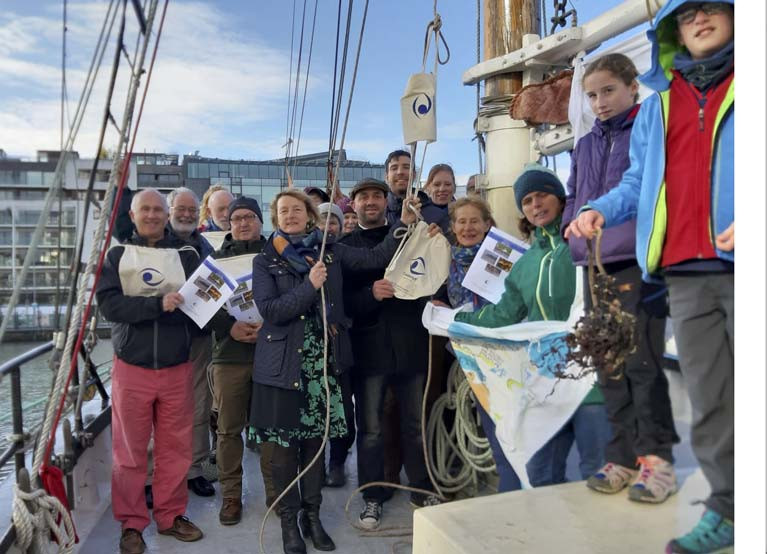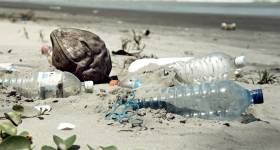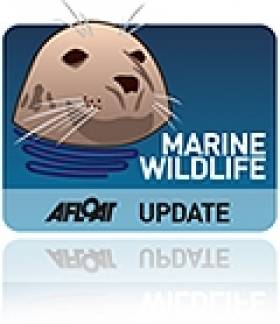Displaying items by tag: marine litter
Volunteer coastal cleaners in East Cork have gained the support of the joint venture behind a new proposed offshore wind farm project to boost their efforts in tackling the scourge of marine litter on the Irish coast.
As the Irish Examiner reports, Clean Coasts Ballynamona have inked a sponsorship deal with the Inis Ealga Marine Energy Park which will enable them to purchase a boat and other equipment to expand their abilities to clean and protect some 80km of coastline.
Clean Coasts Ballynamon comprise more than 300 volunteers who do regular beach cleans — and also manage 34 acres of coastal habitat to promote biodiversity in East Cork.
The Irish Examiner has more on the story HERE.
22.5 Tonnes of Litter Collected Across Ireland for World Ocean Day by Clean Coasts Volunteers
Over 230 clean-ups took place with over 4,000 volunteers answering Clean Coasts’ call to action to protect our ocean this June.
As Afloat reported previously, Wednesday the 8th of June marked the global celebration of World Ocean Day, an initiative that highlights the important role the ocean has for our life and the planet.
This year, Irish environmental charity Clean Coasts joined forces with National Spring Clean for the second year running to provide volunteers and communities in Ireland with free clean-up kits to host a clean-up in honour of World Ocean Day.
Statistics have shown that the number one cause of marine litter is litter dropped in towns and cities and getting involved in World Ocean Day was a great way for residents of non-coastal counties to help prevent litter entering our waterways by tackling the problem at the source.
 Clean Coasts in Cobh in Cork Harbour hosted three clean-ups for World Ocean Day
Clean Coasts in Cobh in Cork Harbour hosted three clean-ups for World Ocean Day
Over 4,000 volunteers collected Around 22.5 tonnes of litter at over 230 clean-ups held both on land and by the coast to prevent litter pollution at the source to ensure it does not end up in the ocean.
The World Ocean Day organisation supports collaborative conservation, working with its global network of youth and organizational leaders in more than 140 countries. In 2021, the initiative changed its name from “World Oceans Day” to “World Ocean Day”. By dropping the “s”, its organisers wanted to highlight the fact that we are all connected by a large ocean. This shared ocean supports all life on the planet, by producing most of the oxygen we breathe and regulating climate. No matter where we live, we all depend on the ocean to survive.
 To mark WOD, Daiane Gomes from Wicklow did a beach clean at Burrow Beach, Dublin, on Saturday 11th June
To mark WOD, Daiane Gomes from Wicklow did a beach clean at Burrow Beach, Dublin, on Saturday 11th June
The organisation had stated that the focus of 2022 would be once again on the 30x30 campaign: to create a healthy ocean with abundant wildlife and to stabilize the climate, it is critical that 30% of our planet’s lands, waters, and ocean are protected by 2030.
 A small underwater clean up at Lough Lene, Co. Westmeath, by Alpha Dive S.A.C in conjunction with Clean Coasts to celebrate World Ocean Day
A small underwater clean up at Lough Lene, Co. Westmeath, by Alpha Dive S.A.C in conjunction with Clean Coasts to celebrate World Ocean Day
Sinead McCoy, Coastal Communities Manager said: “World Ocean Day is a great opportunity for individuals, groups and communities to take action for Ocean Health and lend their voice of support to actions that call for more protection of our Ocean. Clean Coasts were incredibly excited to have over 200 activities happening across Ireland this month so far to mark and support World Ocean Day. The amazing efforts shown on and around World Ocean Day, as well as the work of Clean Coasts volunteers all year round, are incredibly inspiring and provide a great deal of hope for the future of the worlds Ocean.”
Coastal litter caused by drinks containers has halved in one year, but macro and micro debris is still plentiful around the Irish coastline.
As Afloat reported earlier, results from 541 survey areas recorded by a team of Coastwatch Ireland volunteers last autumn found the continued distribution of abandoned vehicles, girders and machinery, household, construction, fishing, aquaculture and angling litter.
Green Party South MEP Grace O’Sullivan was invited to publish the full survey report at an event on board the Brian Boru sailing vessel in Dublin’s Grand Canal Basin on Sunday.
The report notes the “most dramatic change” in the Coastwatch survey results 2019 were in the drinks container counts which halved in one year.
“While this is the biggest reduction ever over a year.... a total of 3333 bottles, 2831 lids and 227 tetra packs is still a lot of drinks related plastic,” it notes.
“It must also be borne in mind that figure is only a one visit survey count in 541 survey units. It is a fraction of what is collected in weekly and daily shore cleans all over the island on over 7300 km,” the survey states.
Plastic drinks container litter was “still the most widespread macro litter” found around Ireland with plastic bottles recorded on 73% of survey sites as a “peak litter item”.
Metal cans were recorded on 60% and bottle lids on 52% of surveyed shores, the report notes.
“Other” items included cotton bud plastic sticks, followed closely by cigarette butts and wrappers, along with balloons, golf balls, farm plastic and full dog pooh bags.
Tyres were found on 19% of shores and surveyors counted 877 tyres. Tyres used to trap peeler crabs for angling competitions or sale in bait shops were recorded in a number of areas, but particularly in the south of the island.
“When crabs moult, they are very vulnerable to predation and normally hide under seaweed or stones,”the survey notes.
“ If tyres are offered, they appear to prefer these,”the survey notes, but this has a detrimental impact on the local crab population and the trapping is not a licensed activity.
Coastwatch Ireland is looking for more information on other trap lines as it says the Government is “set to tackle the problem”.
There were 397 records of fishing, aquaculture and/or angling gear , with fishing nets and net pieces the most frequent (38%), followed by aquaculture waste, traps (24% )and angling waste (18% ).
Large aquaculture waste and abandoned gear was found in 8.5% of the sites surveyed in 2019. The items ranged from abandoned broken trestles to long line floats or sorting equipment, and netlon bags and hooks.
Aquaculture litter “hotspots” of Dungarvan spit and Woodstown beach, Waterford in the south-east, and Lough Foyle on the Donegal coast - known as aquaculture litter hotspots in the past - were “badly littered “, according to surveyor comments.
“Published aquaculture waste management practise reviews and systematic aquaculture operator license compliance checks are needed to tackle this,” Ms Dubsky said yesterday.
Large machine parts were noted on 9.2% of shores, being the only waste category which had risen slightly. Landfill materials were recorded on 16.3% of shores.
In 33 sites (6.6% of shores), the surveyors noted that the earth and stone landfill included construction/demolition waste or appeared to consist mainly of this material.
Surveyor photos included tarmac, walls with polystyrene insulation and wiring.
Ropes and string litter has also increased over the last six years, the survey notes.
Surveyors were also asked to count wet wipes in 2019 as a new pilot initiative, but results were judged unreliable due to the difficulty in separating them from seaweed and sand.
“Judging by shelf space now allocated to wet wipes, they are the latest single-use plastic success story,” the survey notes.
The increase in wet wipe use not only causes pollution, but also sewer blockages, stormwater overflows and treatment plant breakdowns, the survey notes.
Public Lecture On Marine Litter Tonight In Galway
‘Marine litter: are there solutions to this global environmental challenge?’ is the title of a free public lecture at 7pm tonight (Thursday 10 January) in the main concourse of GMIT’s main Galway campus.
Prof Richard Thompson from the School of Biological and Marine Sciences at Plymouth University will deliver the lecture ahead of the second Ecology and Evolution Ireland Conference at GMIT and NUI Galway this weekend.
Prof Thomson will discuss issues surrounding the widespread distribution of plastic debris at the sea surface, on the sea bed and on shorelines.
Nearly 700 marine wildlife species are known to encounter marine litter, with many reports of physical harm resulting from entanglement in and ingestion of plastic.
At the same time it is very clear that plastic items bring many societal benefits. Can these benefits be achieved without emissions of waste to the environment?
Progress requires systemic changes in the way we produce, use and dispose of plastic. Prof Thomson will suggest that a key solution to two major environmental problems, our non-sustainable use of fossil carbon (to produce plastics) and the accumulation waste, lies in recycling end-of-life plastics into new products.
While the two days of the conference on Friday 11 ad Saturday 12 January are now fully booked, attendance at this evening’s lecture is remains open and free to all.
School Removes 12 Tonnes OF Marine Litter From Cork Beaches
To date students from St. Colman’s Community College in Midleton have removed more than 12 tonnes of marine litter from beaches, waterways and rivers across the East Cork area. In recognition of this outstanding achievement, St. Colman’s Community College was named ‘School of the Year’ by An Taisce at the Prestigious 2015 Clean Coasts Ocean Hero Awards – beating over 3,700 primary and secondary schools to take home the award.
“The students of St. Colman’s have been key to the removal of several tonnes of marine litter in the East Cork area, particularly near Ballycotton where they have been dealing with the ongoing issue of fly tipping. They have shown a keen interest in protecting their local beaches and promoting environmental issues in their school and throughout the local community. This has been achieved through awareness raising projects and a website they have put together documenting their action,” said Olivia Crossan, Clean Coasts Programme, An Taisce.
“I would like to congratulate the students and staff of St. Colman’s Community College on this tremendous achievement; the Clean Coasts Ocean Hero ‘School of the Year’ Award is a real acknowledgement of the school’s hard work and dedication shown to this project,” said Ted Owens, Chief Executive, Cork Education and Training Board.
“The Ocean Hero Awards are all about celebrating coastal custodians and inspiring others to join the movement for litter-free seas. St. Colman’s students are wonderful Clean Coast ambassadors and will no doubt inspire more schools to get involved in the movement,” added Olivia Crossan.
More than 870 students from the St. Colman’s school are involved in the initiative, in particular students from 2nd year. Students focused on Ballynamona Beach and the Wetlands Complex in the East Cork and documented their progress, and items recovered, on their website www.ballynamona.eu.
“We are absolutely delighted with this award, it is so important to educate our young people about the importance of protecting the local environment. An Taisce’s Clean Coasts programme is a fantastic way of educating schools and communities. The ‘Think Before You Flush’ programme in particular highlights the problem sanitary products and other items can cause in our marine environment and our wastewater systems if they are flushed down the toilet. Our students witnessed first-hand the harmful effect these products can have on the environment if flushed,” said Proinsias Ó Tuama, Teacher, St. Colman’s Community College.
“The students particularly enjoyed documenting the ‘retro rubbish’ that they found, including 7up bottles from the early 70’s and crisp packets from 2000. Our students are enhancing the value of the coastline by reducing the impact of litter and other environmental damage through this project and we are very proud of their work,” he added.
EU Aims to Reduce Marine Litter
#marinelitter – Marine litter is a serious threat to the coastal and marine environment. Marine habitats are contaminated with man-made garbage and other waste, posing growing environmental, economic, health and aesthetic problems. Marine litter is composed of up to 80 % plastic, and originates from a diverse range of sources. Plastics tend to persist in the marine environment, possibly for hundreds of years.
Therefore it is in the interest of Ireland, with its long coastline, but also of the EU as a whole to tackle this problem. As a first step all Member States were obliged to submit an initial assessment of the state of their marine waters, their definition of 'Good Environmental Status' and the targets they have set to achieve this. However, Ireland along with eight other EU Member States did not submit their reports on time. An up-to-date overview of the Member States' reports can be consulted here: http://ec.europa.eu/environment/marine/eu-coast-and-marine-policy/implementation/scoreboard_en.htm
The Commission is now analysing the reports and intends to publish its assessment in 2013. This will help to raise awareness about this global problem, in line with commitments made in Rio this summer to reduce the incidence and impact of this type of pollution on marine ecosystems.
Environment Commissioner Janez Potočnik said: "At the Rio +20 Earth Summit, World Leaders committed to achieving a significant reduction in marine litter by 2025. The European Commission intends to be at the forefront of this effort, working closely with Member States, Regional Sea Conventions and stakeholders to identify and develop concerted initiatives to tackle the problem."
Next Steps
The Marine Litter paper, together with several on-going pilot projects and the information gathered from Member States on the state of their seas under the Marine Strategy Framework Directive, will be an important input as the Commission considers a possible EU-wide reduction target as a contribution to the commitment made in Rio+20.
The Commission will now consult with Member States and other countries, Regional Sea Conventions, stakeholders and other interested parties on how to best take forward actions on marine litter. This consultation will culminate in an International Conference on Prevention and Management of Marine Litter in European Seas, co-organised by the German Federal Environment Ministry and the European Commission in Berlin in April 2013. Germany's Environment Minister Altmaier and Commissioner Potočnik will be among the participants of this event that will focus Regional Action Plans for Europe's Seas and aims to come forward with a practical toolbox for action.
Background
The environmental impacts of marine litter can be felt mostly on marine fauna, but are also are an extra stress on already fragile marine ecosystems, and can affect human health. Marine litter also hampers tourism, and the removal of litter on shore cost several million Euros a year to coastal areas in Europe.
The Marine Strategy Framework Directive requires Member States to achieve "good environmental status" of their marine waters by 2020. In order to do so, a first step in the implementation is the preparation of an initial assessment (Article 8) which identifies the main threats to the European Seas. In addition, Member States have to translate their definition of 'Good Environmental Status' (GES, Article 9) into concrete criteria against which the monitoring data can be assessed. Finally, Member States have to set national environmental targets (Article 10) which set out their ambition level. Marine litter is one of eleven qualitative descriptors Member States must consider when determining GES. All this work has to be done in cooperation between those countries which shared the four European Seas, the North-East Atlantic, the Baltic, the Mediterranean and the Black Sea.































































